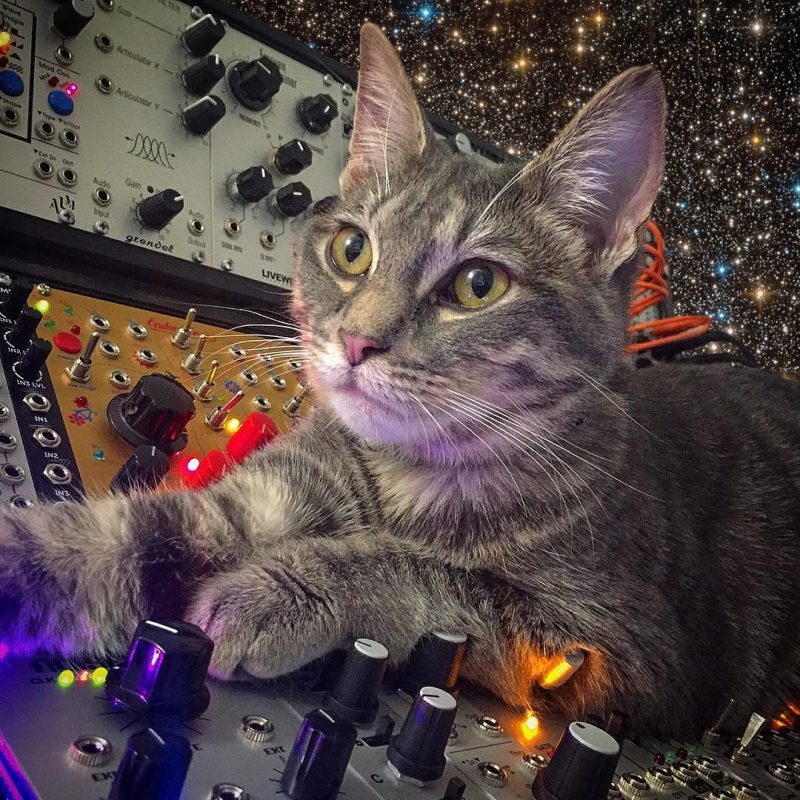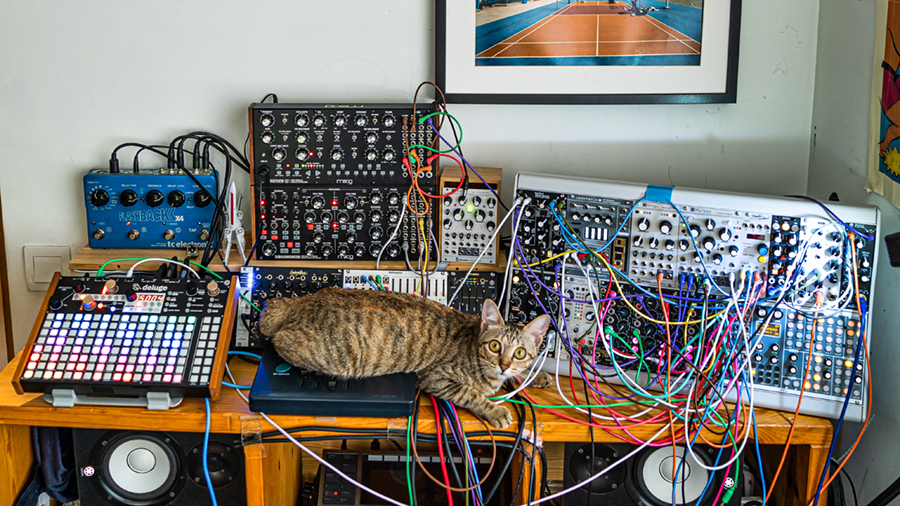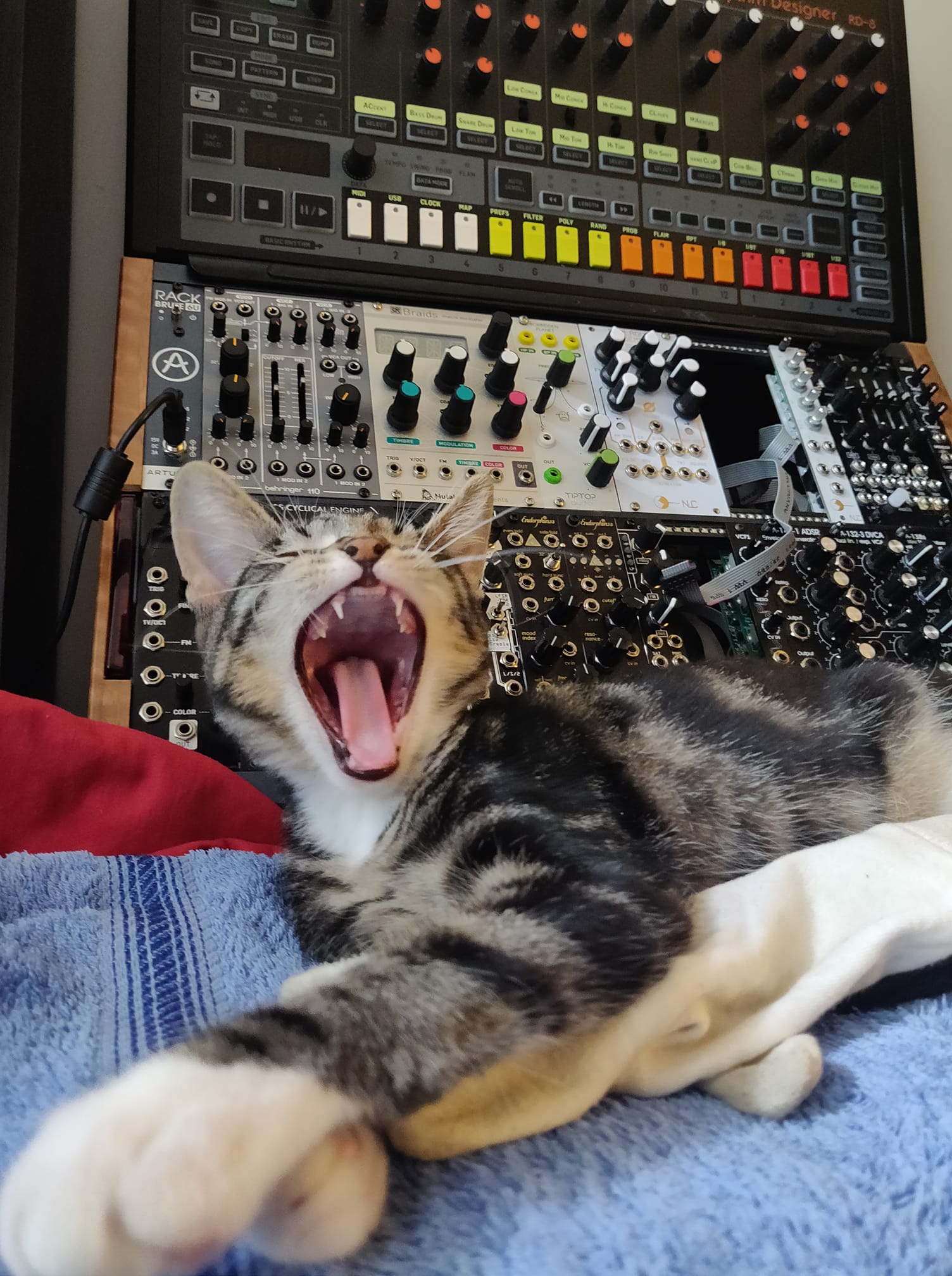
From our friends at Cats on Synthesizers in Space.
In addition to Instagram, you can visit them at their official website.


From our friends at Cats on Synthesizers in Space.
In addition to Instagram, you can visit them at their official website.
Oto seems to be quite enjoying this little jam featuring the Dreadbox Nymphes, controlled by the Oxi sequencer and processed via the Endorphin.es Gost, Chase Bliss Mood, and Death by Audio Rooms.
From ooramusic via Instagram.

The adorable Meelee joins us today from Hong Kong with quite a setup. She has a Synthstrom Audible Deluge, a Moog Mother-32 and Subharmonicon, and sundry Eurorack modules including several from Mutable Instruments, Make Noise, Endorphines, Expert Sleepers, 4ms, Electro-smith, and more. Submitted by Jan Hohmann via our Facebook page.
The Deluge from Synthstrom Audible is a new one for us. It is a portable synthesizer, sampler, and sequencer. A very popular combination these days as we see many instruments that combine these features in different ways.

Vanilla the cat joins us from Guangzhou, China, with an impressive modular system. We see an Erica Synths Plasma Drive, numerous offerings from Endorphines and Make Noise, including a 0-coast; 4MS, Noise Engineering, the popular SQ-1 sequencer from Korg, and even a box from Elektron.
From complexwaveform on Instagram.

This cat is singing to accompaniment from a Behringer RD-8 Rhythm Composer and a modular system housed in Arturia RackBrute 6U case. We see offerings from Mutable Instruments, Dopfer, TipTop Audio, Behringer (again), Endorphines, and more.
Submitted by Michael Caves via our Facebook page.
We opened this year’s NAMM coverage with a visit to the embarrassment of riches among modular synths at Booth 5000, so it is feeding that we return there for our final article. You can read the first installment (with a separate article devoted to the new offerings from Rossum Electro-Music).
We at CatSynth are fans of Make Noise Music and their modules. This year they introduced the TEMPI.

The TEMPI is a “six channel, polyphonic time-shifting clock module” that allows to create and store clock-signal arrangements using both algorithmic and manual techniques. The channels can be linked to do classic clock-divider and multiplier patterns, as well as manual entry. The divider/multiplier are continuous so can go beyond integer ratios. And it has storage for 64 6-clock configurations. I often complain about my current lack of clock sources (especially for driving the Make Noise Rene), so this would be a potential great addition.
Make Noise also released standalone synth, the 0-Coast.

Like the offerings from many manufacturers this year, the 0-coast is intended to be an integrated full synthesizer voice, complete with CV and MIDI control. As one would expect, it’s a bit more esoteric than the equivalents from Roland and Moog. The parameters remind me a bit more of a Serge or Buchla synth.
Pittsburgh Modular also released a new standalone modular system, Lifeforms.

The Lifeforms is a single-voice unit with oscillator and Pittsburgh Modular filter plus integrated controls. It can be paired KB-1 pressure-sensitive controller to make a fully autonomous instrument. You can here a bit of my attempt to play it in this video.
The Lifeforms does seem like a rebrand. While the sound character reminds of me of existing Pittsburgh Modular synths and it retains the iconic knobs, the stenciling on the faceplates is different – the old “typewriter” look of previous modules has been replaced with a more contemporary style. The system would make a good entry to more advanced modular synthesis.
Endorphines was presenting their own colorful line of modules.

The heart of their system is the Furthrrrr Generator, a complex VCO reminiscent of Buchla synthesizers with its simple functions based on harmonic relationships. Similarly, the Fourierrrr module provides waveshaping using harmonic relationships. These are complemented by a serious of function and control modules, including the Shuttle Control that converts between USB, MIDI and CV. You can hear a bit of fun with their modules in this video featuring our little mascot.
WMD presented the new Aperture Filter, a full-module version of their existing Aperture Filter card for Black Market Modular’s ColourCV system.
It is described as “a variable width bandpass Butterworth filter (designed by Tyler Thompson).” You can hear a bit of this filter, along with WMD’s new Performance Mixer.
We conclude with the Haken Continuum, which was on display amonst the modular madness. Not a new instrument by any means, but one that is always fun to return and play. The control surface feels liquidy and comfortable, but familiar enough for an experienced pianist.

The demo included an iPad synth with a string patch that took advantage of the Continuum’s multi-dimensional degrees of freedom. But sitting among the modular synths, one can contemplate other possibilities. To this end, Haken has introduced the CVC that allows direct analog CV control from the fingerboard without the need for a MIDI converter.
There really was a lot at the show that I couldn’t get to, or did not fit into an article. It can always be a bit overwhelming, but very rewarding. In the end, NAMM visits are always a mixture of wanting the new instruments I see, and reaffirming things I wanted from previous years. I will be working on my list…